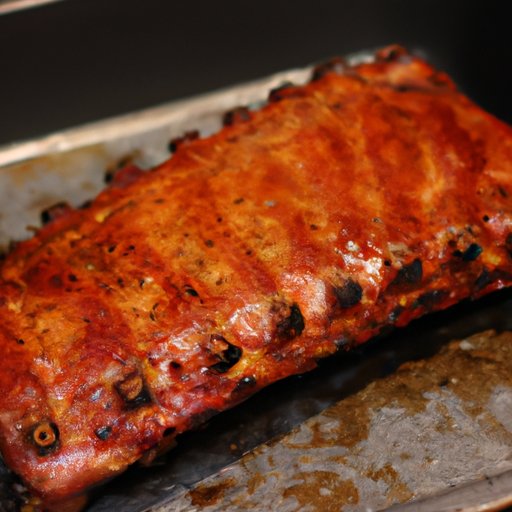
I. Introduction
Pork ribs are one of the most popular meat cuts in the world. Whether you’re a seasoned pitmaster or a beginner cook, ribs are a favorite meal that are perfect for every occasion. They are juicy, tender, and bursting with flavor, making them an excellent choice for any meat enthusiast.
If you want to master the art of preparing and cooking pork ribs in the oven, this article is for you. In this guide, we’ll provide you with useful tips, recipes, cookware options, health benefits, and pairings for making the best pork ribs ever.
II. Step-by-Step Guide
Before you start cooking pork ribs in the oven, it’s essential to select high-quality meat. Look for ribs that are fresh, nicely marbled, and with a vibrant color. You can choose between baby back ribs or spare ribs, depending on your preference. Baby back ribs are leaner and more tender, while spare ribs are thicker and meatier.
Once you have the ribs, it’s time to prepare them. Trimming the ribs involves removing the membrane from the back of the ribs, which can make them tough to chew. Seasoning and marinating the ribs is an essential step that allows the flavors to penetrate deep into the meat. For seasoning, you can use a simple blend of salt, pepper, and paprika. For marinades, you can try a variety of recipes with different herbs, spices, sauces, and juices.
When it comes to cooking, there are several methods, but we recommend using the oven. Preheat the oven to 275°F and place the prepared ribs on a baking sheet or a roasting pan. Cover them with aluminum foil and let them cook slowly for 2.5 to 3 hours, depending on the size and thickness of the meat. Remove the foil and bake them for an additional 30 minutes, brushing them with your favorite sauce. When the internal temperature of the ribs reaches 190°F, they are ready to be served.
Remember to let the ribs rest for about 10 minutes before serving, as this will allow the juices to redistribute evenly. The final result should be a succulent and richly flavored pork ribs.
III. Recipe Variations
If you’re feeling adventurous, try experimenting with different recipes for baked pork ribs. You can prepare Korean-style ribs with soy, garlic, ginger, and sesame oil, or try a spicy Jamaican jerk marinade with chili powder, allspice, and brown sugar. For a classic barbecue flavor, you can use a traditional Memphis dry rub or a tangy Kansas City barbecue sauce.
For extra zest, you can add lemon or lime juice to your marinade, or use honey or maple syrup to add sweetness. You can also try cooking your ribs with beer or wine, which adds depth and complexity to the flavor.
Remember to adjust the cooking time and temperature depending on the type of recipe you choose. Higher heat and shorter cooking times work well for recipes with sweet or acidic marinades, while lower heat and longer cooking times result in more tender, fall-off-the-bone ribs.
IV. Cookware Options
When it comes to cookware options for pork ribs, there are several choices available. A baking sheet or roasting pan can work well, but if you want a deeper, more flavorful result, try using a Dutch oven or a cast-iron skillet. These types of cookware can help lock in flavor and moisture, resulting in juicy and tender pork ribs.
If you use a baking sheet or a roasting pan, make sure to line it with aluminum foil or parchment paper to prevent sticking. Otherwise, you risk losing some of the seasoning and the natural juices of the meat. If you use a Dutch oven or cast-iron skillet, you may need to monitor and adjust the cooking time and temperature, as they retain heat more than other types of cookware.
V. Health Benefits of Pork Ribs
While pork ribs are delicious, they are not the healthiest option out there. However, oven-roasting them can have some health benefits compared to grilling them, which may expose them to carcinogens from the smoke. Oven-roasting also allows the fat to render off, resulting in leaner and less greasy meat.
Pork ribs are an excellent source of protein, vitamins B12, and zinc. However, they are also high in calories and fat, so it’s essential to watch your intake. You can make pork ribs healthier by using leaner cuts of meat, trimming off excess fat, and reducing the amount of sauce or seasoning you use.
VI. Pairings
Pairing pork ribs with the right food and wine can make all the difference. For sides, you can try classic barbecue accompaniments like baked beans, coleslaw, or mac and cheese. If you want to keep it healthy, you can opt for grilled veggies, salad, or mashed sweet potatoes.
When it comes to wine pairing, try red wines with bold and fruity flavors like Malbec, Zinfandel, or Cabernet Sauvignon. These wines go well with spicy or smoky sauces and complement the richness of the pork ribs. For white wines, opt for a Riesling or a Pinot Gris, which have refreshing acidity and can balance the sweetness of the sauce.
VII. Conclusion
Now that you know how to cook pork ribs in the oven, it’s time to put your skills to the test. With the step-by-step guide, recipe variations, cookware options, health benefits, and pairings we’ve provided, you’re ready to impress your family and friends with some mouthwatering pork ribs.
Remember to experiment and try different recipes, seasonings, and sides to find your perfect match. Whether you’re a fan of sweet, spicy, or tangy flavors, there’s a pork rib recipe out there that will make your taste buds sing.





